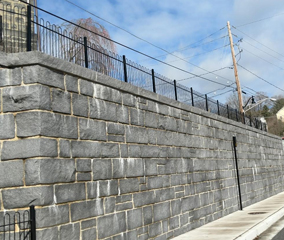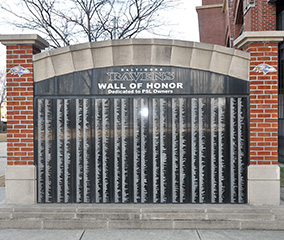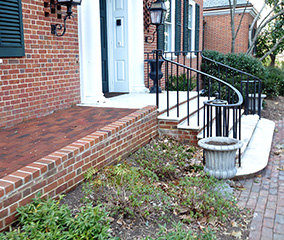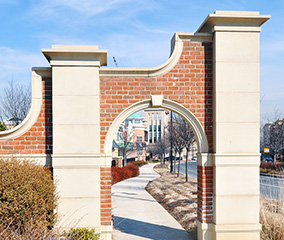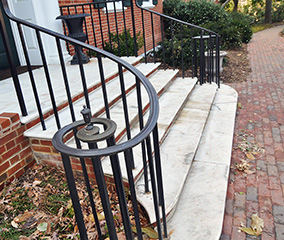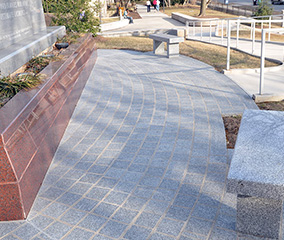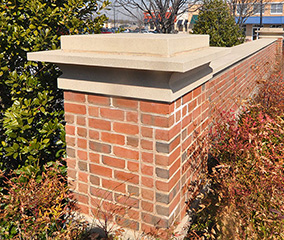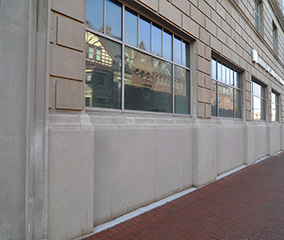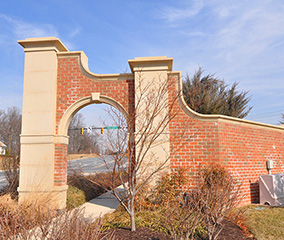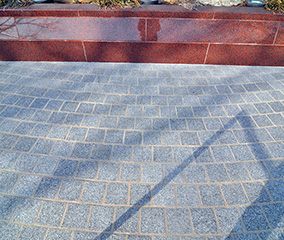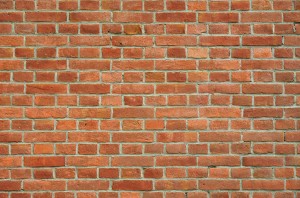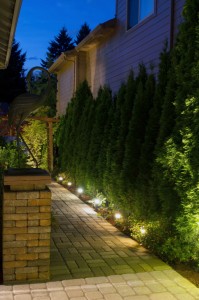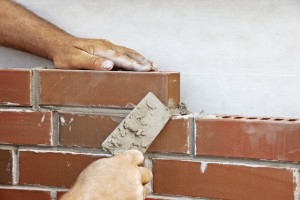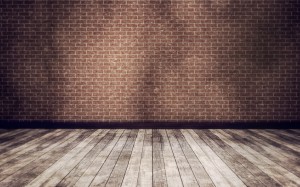Brick veneer and solid brick structures use some of the same construction materials, but their installation techniques are different. Brick veneer is not, contrary to popular belief, composed of thin pieces of brick though it looks almost identical to a solid brick structure. Brick veneer is constructed from steel or wooden framing, covered with wood sheathing or insulation. A single layer of brick is built near each exterior wall and held fast with metal ties. Veneer brick does not support the structure of the house but serves an entirely cosmetic function. There are many benefits and advantages to this method. (more…)
Archive for the ‘ Brick ’ Category
Brick Veneer vs. Solid Brick
Friday, January 29th, 2016How to Create Stunning Hardscaping, Part 2
Thursday, January 21st, 2016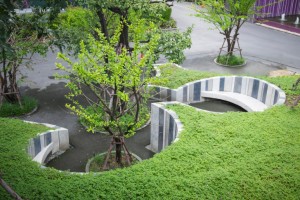
This hardscaping design utilizes different colors and greenery to create a dynamic, eye-catching design.
In continuation of our last blog, here are even more tips on how to create the perfect hardscaping design! As we previously stated, planning is one of the most crucial aspects of creating a stunning hardscaping design. Here are even more planning tips to make sure that you end up with the best commercial hardscaping possible! (more…)
How to Create Stunning Hardscaping, Part 1
Friday, January 15th, 2016Adding some professional hardscaping to your commercial property can greatly increase your property’s appeal and value. Research really pays off when it comes to planning a hardscaping design. You want to keep in mind the unmovable elements of your property, as well as other aspects that should factor into your design. Jumping into a hardscaping project with little planning can result in a design that is defunct after only a few years. Here’s what to keep in mind when you’re planning out your hardscaping design. (more…)
How to Clean Interior Brickwork
Friday, December 18th, 2015You may have read our blog on cleaning exterior brickwork. The methods listed there are great for cleaning walls and walkways outside, but if you’re planning on cleaning inside brickwork, you’ll need to follow a different set of instructions. DelPrete Masonry is here to help you keep all of your brickwork looking as clean and new as possible! You may have a fireplace in your home that you’re thinking of firing up to use for roasting marshmallows or making popcorn. Or perhaps you have a rustic brick wall in your kitchen that needs a good cleaning. When brickwork is in your home, it’s both important to keep it clean as well as use safe cleaning methods. Follow these methods to have pristine, safe interior brickwork! (more…)
How to Clean Exterior Brickwork
Sunday, November 22nd, 2015
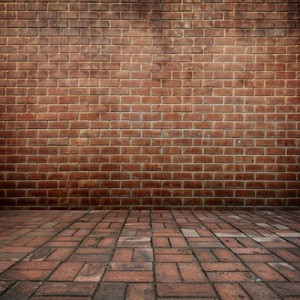
If your brickwork looks like it needs a good cleaning, make sure that you’re using the safest and most effective cleaning methods!
Bricks can be either sealed or unsealed; of course, unsealed bricks require more maintenance to keep up their appearance. Exterior bricks especially should be cleaned regularly. With winter approaching, exterior bricks easily build up salt, dirt, and grime. Make sure that your brickwork is looking its best with our cleaning tips.
Bucket and Brush Method
The bucket and brush method of cleaning is the most widely used and efficient means of cleaning brickwork. It does not require advanced equipment or skill, and it is easy and quick. Here are the steps required to clean your brickwork with this method:
- If your masonry is brand new, wait at least a week to give it its first cleaning. Use a scraping tool to rough away any hardened particles of mortar.
- Use a generous amount of water to saturate the brick wall. This will ensure that the wall does not develop any stains from cleaning, as dry bricks absorb dirt into their brick pores. Using a regular hose, and make sure all the bricks as well as the base of the masonry is drenched.
- Starting from the top, use a long-handled fiber brush to scrub cleaning solution onto the bricks. Sure Clean, Goldblatt Brick Bath, and Superior 800 series are all good choices for cleaning solutions. Be sure to ask your professional mason for their recommended ratios of solution to water.
- After scrubbing, allow the solution to sit and soak for three to six minutes. After soaking, wash off with the hose. Make sure that you’re washing only small parts of the brickwork at a time, rather than the entire wall or walkway. This will ensure that the bricks don’t dry and absorb stains that are impossible to remove.
- Tip: if your bricks are old and weathered, a better way to clean them is to simply use a duster or broom to sweep off dirt and grime. If you think your old bricks can withstand a tougher cleaning, start by testing a small corner first.
Keep Your Masonry Looking Good with Del Prete Masonry!
While there are many other materials that we use at Del Prete Masonry, we’re not about to abandon concrete anytime soon. It has proven its worth many times over and we know that we can bring you a solid masonry structure with it. To find out more about your masonry options including concrete masonry, please contact our office today at 410-683-0650 or email us at mike@delpretemasonry.com. We serve Baltimore City, County, Harford County, Carroll County, Anne Arundel County, and Howard County. Keep up with our blog for masonry related information, and follow us on Facebook, Twitter, and Google+.
Tips for DIY Brickwork
Saturday, November 7th, 2015While some projects will require a professional masonry service, there are other DIY brickwork projects that the average homeowner can complete.
Of course, proper preparation is most important when planning a DIY brickwork project. But, it’s also important that you have the right tips. Listed below are a few tips from Del Prete Masonry to help you get started on your DIY brickwork projects.
Purchase the Proper Tools
Before you start any projects, you want to make sure that you have all of the tools you need to complete your brickwork project efficiently. The last thing you want to do is have to run to the hardware store or order a specialty tool right when you are in the middle of your brickwork. Some of the tools you will need for your DIY project are spades and shovels, buckets, spot boards, bricklaying trowels, tape measures, bolster chisels and a soft hand brush just to name some of the most common tools for brickwork projects.
Focus on Safety
For any DIY project, especially a masonry project, you want to make sure that you and the individuals you are working with are completely safe. During some point of your brickwork, you will most likely find the need to cut some bricks to a certain size. When you do this, make sure that you and everyone working with you has his or her safety goggles on. Goggles are just like any of the tools you use, and goggles are necessary for your DIY brickwork.
Laying Bricks
Laying bricks is an art for a professional masonry service, but you can complete a basic brickwork project with a few tips. Always make sure that when you lay bricks the vertical joints are staggered. This gives the brickwork more support and strength. Also, remember that not all bricks are going to be perfectly square, so use your best judgment on whether you feel you need to cut the bricks. For any extensive projects, make sure to work with professional masonry service to make sure your project is absolutely perfect.
Del Prete Masonry
For any questions regarding new masonry construction, feel free to contact Del Prete Masonry. Our masonry restoration professionals have the experience and history of satisfied clients to prove that we’ll get the job done right, and cost-effectively. To get started with your masonry restoration project, please contact our office today at 410-683-0650 or email us at mike@delpretemasonry.com. We serve Baltimore City, County, Harford County, Carroll County, Anne Arundel County, and Howard County. Keep up with our blog for masonry related information, and follow us on Facebook, Twitter, and Google+.
Brick Cleaning Do’s and Don’ts
Thursday, August 6th, 2015Even with brick’s tough reputation, it still needs a good cleaning every once in a while. In the same light, if you clean your brick without knowing the proper way, there’s a good chance you can damage it as well. And what’s worse, brick cleaning can be a challenge in itself – whether inside or outside, brick is susceptible to dirt, soot, and even mold. But don’t worry! Armed with a little elbow grease and the right materials, brick cleaning can be a success. If you follow these tips, you’re sure to have your bricks looking good as new in no time.

Armed with a little elbow grease and the right materials, brick cleaning can be a success. If you follow these tips, you’re sure to have your bricks looking good as new in no time.
Brick Cleaning How-To
When brick cleaning, it’s best to start off with the mildest method and eventually work up to the harshest. You should always start by brushing off the excess debris and dirt on top first, and remember that wet brick hides stains, so repeating steps may be necessary in the future. These brick cleaning methods are listed from mildest to harshest and should be tried in the order they appear. (more…)
How to Prepare for New Masonry Construction
Sunday, April 5th, 2015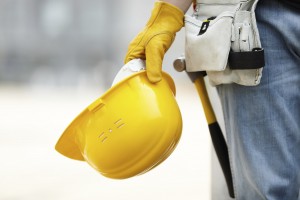 There are plenty of reasons why you may be seeking to hire us to build you a brand new structure. You might need some flatwork done, a monument built, walls put in, or a structure you’ve been dreaming of for a long time. There are things you need to think through before you make the call so that we can ensure that you will have the smoothest process from idea to finished structure. We are more than happy to answer your technical questions along the way, but here are some things you might want to consider on your own. (more…)
There are plenty of reasons why you may be seeking to hire us to build you a brand new structure. You might need some flatwork done, a monument built, walls put in, or a structure you’ve been dreaming of for a long time. There are things you need to think through before you make the call so that we can ensure that you will have the smoothest process from idea to finished structure. We are more than happy to answer your technical questions along the way, but here are some things you might want to consider on your own. (more…)
Building Better with Brick
Monday, February 2nd, 2015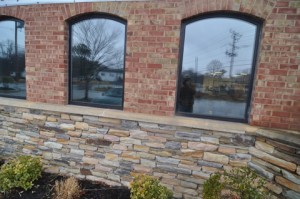 Spring is coming, your tax returns are around the corner, and you’re planning a new home improvement project. Del Prete Masonry is here to help, and to lead off we’ll explain why brick is the best material for your new home improvement project.
Spring is coming, your tax returns are around the corner, and you’re planning a new home improvement project. Del Prete Masonry is here to help, and to lead off we’ll explain why brick is the best material for your new home improvement project.
Strong and Safe
Fired brick, or ceramic brick, has been in use for thousands of years as a strong, long lasting material, durable to the elements. The component elements of brick can be altered to change its attributes, for example, brick can be made lighter, or stronger depending on the mixture. The raw materials and temperature that bricks are fired at can also be used to change the temperature of the bricks. Brick does not warp, rot, or erode as other construction materials might. It is also fireproof, and brick masonry has been shown to reduce the chances of a home being destroyed by a fire.
Low Maintenance and Energy Efficient
Brick is requires little maintenance, and has a high thermal mass, both aspects which make it an energy efficient building material.
Brick masonry construction does not need to be repainted, sanded, or refinished, like painted wood or plaster, and it does not fade and need to be replaced like vinyl siding does. All the maintenance brick needs is an occasional cleaning. This saves you time, energy, and money.
Brick’s thermal mass also makes it energy efficient. The thermal mass of a material measures how a material absorbs and releases heat. Another way to put it would be as a measurement of the thermal “inertia” of a material. Materials like iron are good thermal conductors and have a low thermal mass, it absorbs and releases heat quickly. Brick acts as a material with a high thermal mass, and has a high thermal inertia. Brick keeps the house cool during the day, slowly absorbing and storing heat from the surrounding air and sun. When night comes time and the outside temperature starts to cool, the brick releases the heat it has absorbed into the home, and then starts the process all over again with dawn. Materials with a high thermal mass, like brick, are best in temperate climates like where we are.
Aesthetically Flexible
As a design material, fired brick is one of the most flexible materials around. Brick come in many colors, from whites and yellows, to the more common pinks, reds, and browns. Brick may even be purple or black. Bricks can be made to all be the same color, or you can alternate colors, and construction patterns to make designs in whatever you’re constructing. It can be used in classical as well as contemporary design. And brick can be used well with other materials as a complementary or contrasting feature.
Want your next Home Improvement project done with Brick?
Call Del Prete Masonry. As Maryland’s foremost experts on masonry repair, construction, and demolition, our skilled teams have what it takes to provide you with the very best in masonry contracting. At Del Prete Masonry, we’ve got the answers you’re looking for.
To find out more about your masonry repair options, please contact our office today at 410-683-0650 or email us at mike@delpretemasonry.com. We serve Baltimore City, County, Harford County, Carroll County, Anne Arundel County, and Howard County. Keep up with our blog for masonry related information, and follow us on Facebook, Twitter, and Google+.
The History of Brick
Friday, January 16th, 2015At Del Prete Masonry, we’re proud to continue the historic tradition of masonry, a craft that extends thousands of years into our past, with a history as storied and fascinating as the chronicle of any nation. Today, we’re looking backwards into the history behind one of the most crucial and powerful items of our trade: the humble brick.
The Middle East
As far as historians can tell, the earliest discovered bricks date as far back as 7500 BC. These early bricks were dried, which means that they were made out of clay-laden dirt and mud, then dried under sunlight until they were hearty enough to be used in construction. The oldest known bricks hail from a part of the planet that is now Syria. Other discoveries, which date as far back as 7000 BC, include bricks from the ancient city of Jericho and the Egyptian fortress of Buhen which ran along the west bank of the Nile River.
China
As early as 2000 BC, bricks were certainly being used in Chinese architecture. Scientists and scholars have even established that the Chinese were already mass-producing bricks roughly 300 years ago during the Western Zhou dynasty. In 1368 AD, under the Ming Dynasty, bricks were already being fired in kilns. To make these bricks clay and water were mixed together, then trampled over by oxen who beat it into a paste. The paste was then lain in wood frames and smoothed with a wiry bow. The bricks were then stamped with the brickmaster’s insignia and loaded into a wood-fueled kiln and removed while the kiln was still burning.
Europe
The Ancient Greek and Roman civilizations also used fired bricks. The Romans designed and perfected the use of mobile, cart-bound kilns and constructed massive brick buildings and structures all over their empire bearing the seal of the Roman legion. The middle ages saw brickmaking finally make its way to northern Europe and was popular in places without native rocks suitable for construction. Some of these buildings still stand today in Denmark, Germany, Russia, and Poland. This kind of brickmaking and architecture would eventually transform into the style that became popularized during the Italian Renaissance.
At Del Prete, We Know Where We’re Coming From
We recognize the importance of history and our professionals know everything about brick masonry, from practical skills to historical facts. For other questions regarding brick masonry, feel free to contact Delprete Mansonry. Our brick masonry professionals have the experience and history of satisfied clients to prove that we’ll get the job done right, and cost-effectively. To get started with your brick masonry project, please contact our office today at 410-683-0650 or email us at mike@delpretemasonry.com. We serve Baltimore City, County, Harford County, Carroll County, Anne Arundel County, and Howard County.
Keep up with our blog for masonry related information, and follow us on Facebook, Twitter, and Google+.









